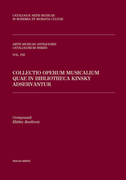Collectio operum musicalium quae in Bibliotheca Kinsky adservantur
Eliška Šedivá
Tuesday, November 26, 2013

The Thematic Catalogue for the Kinsky Library’s Music Collection
The music collection at the Kinsky Library, which is administered by the National Museum Library (CZ-Pn), was first examined in detail in 2010. More than one thousand individual musical documents dating from the end of the 18th and the first half of the 19th centuries, either bound into extensive albums or gathered loosely in individual folders, were found in one of the tall Empire-style cabinets located in the reconstructed areas of the library hall in the Golz-Kinsky Palace on the Old Town Square in Prague. The manuscript section, which constitutes almost half of the collection (373 shelfmarks), has been included in the RISM A/II database. Together with the 274 shelfmarks allocated to the printed music, it has been compiled in the form of the thematic catalogue.
The Kinsky music collection apparently arose when the private music collections of Princess Marie Charlotte Caroline Kinsky, born the Baroness of Kerpen (1782-1841), and her daughter-in-law Princess Wilhelmine Elisabeth Kinsky, born as the Countess of Colloredo-Mansfeld (1804-1871), were brought together. The music from these two collections was used both for study purposes (vocal solfeggios, arias, instrumental exercises, keyboard pieces) and as commemorative items for various social events (e.g. music at the Prague carnival balls). The typology of the collection is mainly given by the musical interests and performance skills of the individual owners, as well as their relationships with the composers. There is also a series of works with official dedications to this aristocratic family.
The collection contains music manuscripts and printed music from the period between approximately 1785 and 1840. The older manuscripts (before 1800) mainly came from Viennese copyists’ workshops, after 1800 we can find many copies from Prague workshops. Printed music was mainly the work of Viennese, Leipzig and Prague publishers.
Some words about the repertoire are in order. Operatic works of the last third of the 18th century and the beginning of the 19th century constitute one of the pillars of the Kinsky collection. There are mostly excerpts (scores and short scores) from operas by G. Paisiello, D. Cimarosa, A. Salieri, V. Martín y Soler, W. A. Mozart and others. Operas by composers of the following generation (e.g. D. F. E. Auber, F. A. Boieldieu, G. Rossini and C. M. von Weber) appear predominantly in printed form. Stage works are also represented by a singspiel, ballet and musical setting for a play. The collection’s second pillar consists of songs. A large number of Italian ariettas and canzonettas have been preserved both in the original cycles and as individual works by authors such as B. Asioli, B. Bortolazzi, G. Crescentini, G. Liverati, G. Righini and others. French chansons and romances are also included (H. Audiffret, F. Blangini). The dominant composer of songs in German in this collection is F. H. Himmel. The collection’s instrumental repertoire mainly represents period dance music arranged for keyboard instruments of guitar and various instructive works. There are many works by Czech composers (J. Chmelík, J. F. Jedlička, V. Jírovec, V. Maschek, J. A. Vitásek, A. Volánek, J. V. Tomášek) and there is also group of composers with aristocratic origins (C. F. von Schönborn, A. H. Radziwill, Counts Rohan and Kolowrat). We can find also some pieces by women composers (A. von Clam-Gallas, L. Reichardt, N. I. Kurakina, A. Wolf Mrasek).
The taxonomy of this thematic catalogue has been conceived in such a way so that every entry provides the fullest possible information on the musical documents preserved in this music collection. The methodology directly follows the rules for describing musical sources for the cataloguing of music manuscripts and printed music for RISM series A/I and A/II. The catalogue has been divided into two parts, for manuscripts and printed music, according to the type of material. Furthermore, the works have been arranged alphabetically by the composer’s surname. A relatively common feature in this collection is the presence of thematically-compiled albums, which have required a separate section in the catalogue. Quick orientation in the catalogue is ensured by means of the name and material indexes, which refer both to the foreword and to the appropriate entry in the catalogue.
Share Tweet EmailCatégorie: Nouveautés

